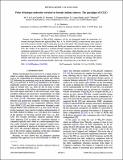Por favor, use este identificador para citar o enlazar a este item:
http://hdl.handle.net/10261/14517COMPARTIR / EXPORTAR:
 SHARE SHARE
 CORE
BASE CORE
BASE
|
|
| Visualizar otros formatos: MARC | Dublin Core | RDF | ORE | MODS | METS | DIDL | DATACITE | |

| Título: | Polar di-halogen molecules solvated in bosonic helium clusters: The paradigm of ICl(X) |
Autor: | Lara Castells, María Pilar de CSIC ORCID ; Prosmiti, Rita CSIC ORCID; Delgado Barrio, Gerardo CSIC ORCID ; López Durán, David; Villarreal, Pablo CSIC ORCID; Gianturco, Franco Antonio; Jellinek, J. | Palabras clave: | Helium neutral molecules Iodine compounds Atomic clusters Molecular configurations SCF calculations Potential energy functions Ab initio calculations Infrared spectra Spectral line shift [PACS] Spectroscopy and geometrical structure of atomic and molecular clusters [PACS] Ab initio calculations (atoms and molecules) [PACS] Raman and Rayleigh molecular spectra including optical scattering [PACS] Diffuse molecular spectra; predissociation, photodissociation |
Fecha de publicación: | 28-nov-2006 | Editor: | American Physical Society | Citación: | Physical Review A 74(5): 053201 (2006) | Resumen: | Energies and structures of 4He(N)-ICl(X) complexes, N ≤ 30, are determined within the framework of a recently developed Hartree-like approach [Phys. Rev. A 71, 033203 (2005)], in which the He atoms play the role of the electrons and the I and Cl atoms play the role of the nuclei. The potential energy of the system is represented as a sum of the He-ICl triatomic and He-He pair interactions fitted to results of ab initio calculations. The validity of the approach is evaluated through comparisons with the results of "exact" variational calculations performed for the cases of N=1 and 2. The procedure, which furnishes also the wavefunctions, allows for simulation of the infrared spectra of the ICl molecule embedded in the bath of He(N) clusters. Similarly to the case of the "bare" ICl, when the clusters are formed from bosonic He atoms the absorption selection rules lead only to the P and R branches of the spectra (the Q branches are missing). The spectra exhibit a monotonically increasing blueshift, albeit with a decreasing rate, as the cluster size increases. | Descripción: | 11 pages, 6 figures, 5 tables.-- PACS nrs.: 36.40.Mr; 31.15.Ar; 33.20.Fb; 33.80.Gj. | Versión del editor: | http://dx.doi.org/10.1103/PhysRevA.74.053201 | URI: | http://hdl.handle.net/10261/14517 | DOI: | 10.1103/PhysRevA.74.053201 | ISSN: | 1050-2947 |
| Aparece en las colecciones: | (CFMAC-IFF) Artículos |
Ficheros en este ítem:
| Fichero | Descripción | Tamaño | Formato | |
|---|---|---|---|---|
| polar_dihalogen_PRA_2006.pdf | 798,77 kB | Adobe PDF |  Visualizar/Abrir |
CORE Recommender
SCOPUSTM
Citations
33
checked on 20-abr-2024
WEB OF SCIENCETM
Citations
36
checked on 23-feb-2024
Page view(s)
320
checked on 23-abr-2024
Download(s)
265
checked on 23-abr-2024
Google ScholarTM
Check
Altmetric
Altmetric
NOTA: Los ítems de Digital.CSIC están protegidos por copyright, con todos los derechos reservados, a menos que se indique lo contrario.
